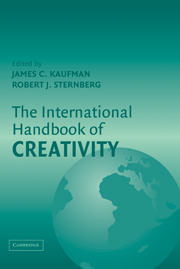Book contents
- Frontmatter
- Contents
- Acknowledgments
- List of Contributors
- 1 Introduction
- 2 Creativity Research in English-Speaking Countries
- 3 Creativity in Latin America
- 4 History of Creativity in Spain
- 5 Past, Present, and Future Perspectives on Creativity in France and French-Speaking Switzerland
- 6 Creativity in Italy
- 7 Creativity Research in German-Speaking Countries
- 8 Creativity Under the Northern Lights
- 9 Creativity in Soviet–Russian Psychology
- 10 Creativity Studies in Poland
- 11 Research on Creativity in Israel
- 12 Creativity in Turkey and Turkish-Speaking Countries
- 13 Development of Creativity Research in Chinese Societies
- 14 Creativity – A Sudden Rising Star in Korea
- 15 Culture and Facets of Creativity
- 16 African Perspectives on Creativity
- 17 Creativity Around the World in 80 Ways … but with One Destination
- Author Index
- Subject Index
- References
6 - Creativity in Italy
Published online by Cambridge University Press: 05 June 2012
- Frontmatter
- Contents
- Acknowledgments
- List of Contributors
- 1 Introduction
- 2 Creativity Research in English-Speaking Countries
- 3 Creativity in Latin America
- 4 History of Creativity in Spain
- 5 Past, Present, and Future Perspectives on Creativity in France and French-Speaking Switzerland
- 6 Creativity in Italy
- 7 Creativity Research in German-Speaking Countries
- 8 Creativity Under the Northern Lights
- 9 Creativity in Soviet–Russian Psychology
- 10 Creativity Studies in Poland
- 11 Research on Creativity in Israel
- 12 Creativity in Turkey and Turkish-Speaking Countries
- 13 Development of Creativity Research in Chinese Societies
- 14 Creativity – A Sudden Rising Star in Korea
- 15 Culture and Facets of Creativity
- 16 African Perspectives on Creativity
- 17 Creativity Around the World in 80 Ways … but with One Destination
- Author Index
- Subject Index
- References
Summary
INTRODUCTION
According to an oft-quoted statement by Ebbinghaus, psychology has a long past and a recent history. Even though psychological topics have been explored by historians, philosophers, theologians, religious and spiritual guides, poets, and novelists from the early stages of Western culture, the scientific investigation of such topics began only in the nineteenth century. A similar comment could be made about the psychological study of creativity in Italy, as well as, presumably, in other countries (see Albert & Runco, 1999). Italian research on creativity has a recent history but a long past. Indeed, even though studies explicitly analyzing, assessing, and promoting creativity only appeared in Italy in the 1960s, issues associated with creativity were pondered earlier, under different labels within more general theoretical topics.
Human creativity represents one of the most important and intriguing aspects of psychological functioning, but it is still in search of a clear and unequivocal definition. If we assume, in general terms, that creativity concerns the possibility that human beings produce, either in a physical–material or in a cultural sense, something that did not exist before and that is appreciated by other people because of its practical, intellectual, or aesthetic value, then we realize that the problem of explaining how humans can succeed in this endeavor was already being addressed by many scholastic thinkers in Italy in the Middle Ages.
- Type
- Chapter
- Information
- The International Handbook of Creativity , pp. 124 - 166Publisher: Cambridge University PressPrint publication year: 2006
References
- 4
- Cited by



